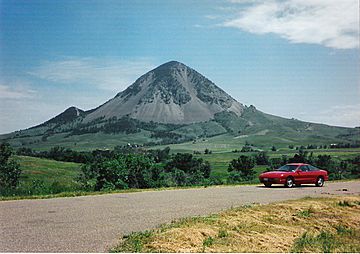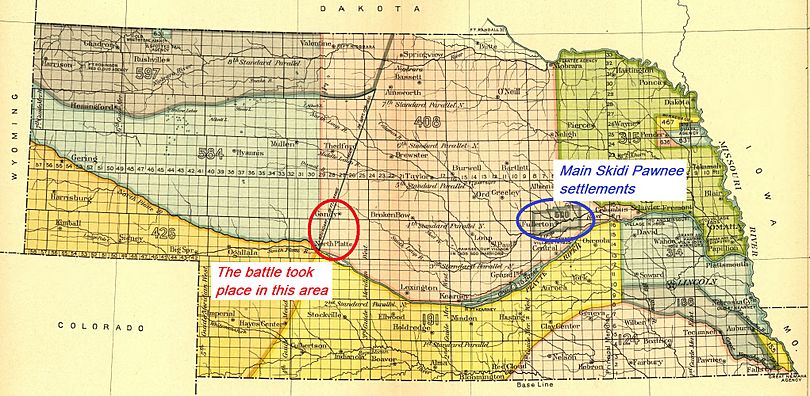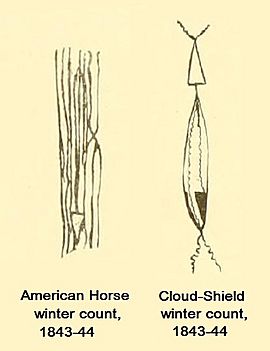The Pawnee capture of the Cheyenne Sacred Arrows facts for kids
Quick facts for kids Intertribal battle |
|||||||
|---|---|---|---|---|---|---|---|
|
|||||||
| Belligerents | |||||||
| Cheyenne, Arapaho and Lakota | Skidi Pawnee and some Pawnee from the South Bands | ||||||
| Commanders and leaders | |||||||
| Unknown | Chief Big Eagle, keeper of the Morning Star bundle | ||||||
| Strength | |||||||
| The whole Cheyenne tribe and an unknown number of allies | Unknown, but a big Pawnee camp | ||||||
| Casualties and losses | |||||||
| Unknown | Unknown | ||||||
| The Cheyenne lost the Sacred Arrows during the battle, described as "the greatest disaster" in Cheyenne history. | |||||||
The Pawnee capture of the Cheyenne Sacred Arrows happened around 1830 in central Nebraska. It occurred when the Cheyenne tribe attacked a group of Skidi Pawnee who were hunting bison. The Cheyenne had with them their very important sacred bundle of four arrows, known as the Mahuts.
During the fight, this special, ceremonial object was taken by the Pawnee. The Cheyenne first made new replica arrows. However, they also tried hard to get the original arrows back. They managed to get one arrow back directly from the Pawnee. A second arrow was later captured by the Lakota and returned to the Cheyenne in exchange for horses. The two replica arrows that were no longer needed were then returned to the Black Hills. This is where the original arrows were believed to have come from. Over time, the bundles were made complete again, and the traditions and ceremonies continue even today.
Contents
Who Were the Pawnee and Cheyenne?
The Pawnee People
The Pawnee likely lived in villages made of earth lodges. These villages were in what is now Nebraska and northern Kansas. They had been there since at least the 1500s.
Around the time of this battle, the Skidi Pawnee lived along the Loup River in central Nebraska. Other Pawnee groups, like the Chawi, Kitkahahki, and Pitahawirata, were known as the South Bands. They lived south of the Platte River. A few years later, these groups moved north to join the Skidi Pawnee.
The Pawnee grew crops like corn near their villages. But they also went on long group hunts for bison in both summer and winter. When they were out on the plains, they lived in tents made of animal skins and tipis.
The Cheyenne People
The last groups of Cheyenne Indians moved across the Missouri River from eastern North Dakota. This happened in the late 1700s. For a while, they lived south of the Cannonball River near other Cheyenne villages.
In the early 1800s, they mostly camped north of the North Platte. Around 1825, some Cheyenne groups moved south. They had heard about many wild horses between the Platte River and the Arkansas River. This move brought them close to the hunting grounds used by the Pawnee.
The Pawnee and Cheyenne had been enemies for a long time. They had fought each other since the Cheyenne first moved into the area. They would capture horses from each other and fight on the plains. However, neither side ever gained a lasting advantage.
What Were the Sacred Arrows?
According to Cheyenne stories, their hero Sweet Medicine received the Sacred Arrows. He got them as a gift from special beings. This happened after he was taken into a sacred cave at Bear Butte in the Black Hills.
The bundle contained two Buffalo Arrows, which were painted red. These arrows helped with good hunting. The other two were Man Arrows, painted black, and were used for war. When these four arrows were tied to a lance in two pairs and carried into battle after a special ceremony, they promised victory. These arrows had been present when a large Crow camp was completely destroyed at Tongue River in 1820.
Renewing the arrows is one of the most sacred Cheyenne ceremonies. It traditionally happens every summer. It also takes place after sad events, like a killing or other tragedy.
How the Battle Started
A year before this big battle, a group of Cheyenne warriors planned to raid the Pawnee near the lower Platte River. The Pawnee discovered them and killed all the Cheyenne warriors. This was similar to what happened ten years earlier when thirty Cheyenne Bowstring warriors were killed by the Crow. The Cheyenne tribe promised to get revenge for their lost warriors.
In the summer of 1830, the entire Cheyenne tribe began to move down the Platte River. Some Lakota and Arapaho allies joined them. White Thunder, who was the special keeper of the Sacred Arrows, led them with his wife.
Scouts were sent out to find the enemy, but they found no trace of the Pawnee. By chance, the group met four messengers. These messengers were from a group of scouts who had been killed by the Pawnee. Finally, the scouts found a large Pawnee camp at the head of the South Loup. (The Pawnee said their camp was somewhere on the Platte River).
After marching for another day and night, the Cheyenne group reached a spot near the Pawnee camp early in the morning. The warriors got ready for battle. The women and children gathered in a circle where they could see the flat area that would soon become a battlefield. The Pawnee camp seemed to be hidden behind a ridge.
The Cheyenne warriors and their allies formed two separate groups. The Sacred Arrows were placed in front of one group. The other group followed a man wearing the sacred Buffalo Hat. These two powerful items were believed to protect everyone behind them and make the enemy helpless.
Meanwhile, the first bison hunters left the Pawnee camp. They almost walked right into the Cheyenne army. The battle began, and White Thunder could not stop the Cheyenne. Without performing the necessary ceremony, he gave the arrow bundle to a medicine man named Bull. Bull quickly tied the bundle to the middle of his lance. Then he got on his horse and tried to catch up with the other warriors.
The Battle for the Arrows
The battle was very fierce. An old Pawnee man, who was sick and tired of living, had asked his relatives to carry him to the very front line of the battle. He sat on the ground with a bow and some arrows. Bull wanted to count coup on this enemy, even though other Cheyenne tried to stop him.
The old Pawnee avoided Bull's lance thrust and grabbed it. He pulled the lance away from Bull, who slowly rode back to his own line. "This spear must be a wonderful spear!" shouted the Pawnee when he saw the special bundle wrapped in hide tied to it. Other Pawnee rushed forward. Chief Big Eagle arrived first and secured the lance before the Cheyenne could get it back.
During the fight, Chief Big Eagle wore the Wonderful Leggings of Pahukatawa. These leggings were part of a tribal war bundle and seemed to make Big Eagle fearless. Because of the power of these leggings, the Skiri [Skidi] captured the amazing Cheyenne arrows. Big Eagle also wore a red shirt and a government medal on his chest. He rode a small spotted horse throughout the battle. Because of this, the Cheyenne remembered him as Spotted Horse or Big Spotted Horse.
The Cheyenne say they killed the old Pawnee on the battlefield. However, the Pawnee say he died the next summer during a Cheyenne attack on an almost empty Pawnee village.
With the Sacred Arrows gone and their morale (their confidence and spirit) low, the Cheyenne could not stand against a new attack by the Pawnee and retreated. It is not known how many people were killed on either side. Later, the Cheyenne retreated up the Platte River, sad about losing the arrows. George Bent described it as "... the greatest disaster the Cheyennes ever suffered."
What Happened After the Battle?
Pawnee Chief Big Eagle realized he had captured something incredibly important when he looked at the arrows. He was the keeper of the Morning Star bundle of the Skidi Pawnee. He placed three of the captured arrows into that bundle.
Some time after the battle, the best Cheyenne arrow makers created four new Sacred Arrows to replace the lost ones. However, they also tried in different ways to get the original arrows back. Once, they invited Big Eagle and the Pawnee to their camp. They promised the guests many horses in return for the four arrows. Big Eagle expected a trick and brought only one arrow, wrapped in a bundle. As he feared, a Cheyenne rode away with the arrow when no one was watching. Another story says that three Cheyenne men, White Thunder, Old Bark, and Doll Man, traveled to a Skidi village in 1835. They were welcomed in Big Eagle's lodge and given one Buffalo Arrow. Even though they offered more than a hundred horses, no more arrows were returned.
In the winter of 1843 to 1844, or possibly in 1837, the Lakota attacked a Pawnee village. They found a single medicine arrow. They recognized it as a Man Arrow and returned it to the Cheyenne. In exchange, the Cheyenne gave them one hundred horses.
Now, two of the newly made Sacred Arrows were extra. A ceremony was held, and the Cheyenne left two of the new arrows in a bundle. They placed them in a crack in the Black Hills, near where Sweet Medicine had received the original arrows. They stayed there for a long time, and Cheyenne travelers sometimes visited them, before they eventually disappeared.
Later attempts to get the remaining two original arrows back were made in the 1890s and 1930s, but they were not successful. The fact that the remaining arrows were not returned caused sadness and anger for many generations.
|




